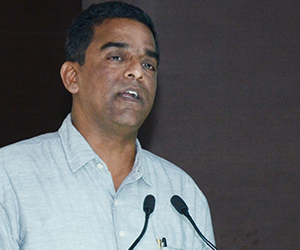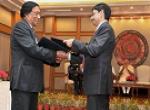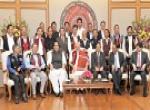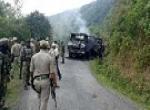Late on Monday evening, the question uppermost in the mind of every observer who watches the north-east closely was: Will the Naga accord usher in permanent peace in the region, wracked by conflict for decades? More than 12 hours after the pact was signed between the Government of India and the Issac-Muivah faction of the National Socialist Council of Nagaland (NSCN-IM)—arguably the most influential underground outfit in the region in the past quarter century—the details are as yet to emerge. What is however apparent is that both sides have met each other half way to pave way for what is likely to be a major breakthrough in the chequered history of insurgency in India’s north east.
There are reasons to be cautiously optimistic. For one, the most contentious issue of creating a ‘Greater Nagaland’ by integrating all Naga-inhabited areas in the region and by consequence redrawing the boundaries of existing states, is off the table. Sources privy to the details of negotiations indicate that the NSCN (IM) has dropped the demand for territorial integration of the Naga areas spread over Manipur, Assam and Arunachal Pradesh—all adjacent states of Nagaland—and has instead settled for ‘cultural’ integration of the Nagas. This will go a long way in allaying fears in neighbouring states about losing territory. Manipur, in particular, has reacted violently to such a suggestion. In the past.
Secondly, the Government of India has acknowledged the ‘unique’ status of the Nagas. It has been an article of faith for generations of Naga leaders to be treated as unique. As a government press note said, in the wake of the signing of the accord between NSCN(IM) leader T. Muivah and GoI interlocutor Ravindra Narayan Ravi: “This agreement will end the oldest insurgency in the country. It will restore peace and pave the way for prosperity in the North East. It will advance a life of dignity, opportunity and equity for the Naga people, based on their genius and consistent with the uniqueness of the Naga people and their culture and traditions.”
RN Ravi, a former Intelligence Bureau officer with decades of experience in the region, also managed to persuade the Naga leaders about climbing down from their demand for ‘sovereignty.’ So in return for accepting the Naga uniqueness, the Nagas have agreed to work within the ambit of the Indian Constitution. As the government press note said: “The NSCN understood and appreciated the Indian political system and governance.”
While the Government of India has accepted the ‘uniqueness’ of the Nagas, the Naga leaders have also dropped their demand for sovereignty. A government release in the wake of the signing acknowledged as much when it said: “The sustained dialogue between the two sides, conducted in a spirit of equality, respect and trust, deepened their mutual understanding and confidence, and enabled the two sides to reach an equitable agreement. The Government of India recognized the unique history, culture and position of the Nagas and their sentiments and aspirations. The NSCN understood and appreciated the Indian political system and governance.”
"Today's agreement is a shining example of what we can achieve when we deal with each other in a spirit of equality and respect, trust and confidence; when we seek to understand concerns and try to address aspirations; when we leave the path of dispute and take the high road of dialogue," Prime Minister Narendra Modi said after the accord was signed.
VS Atem, a senior NSCN leader told the Nagaland Post that the NSCN (I-M) has made a “historic agreement” of reconciliation and unity on the basis of political and historical right of the Nagas. He maintained that both Shillong Accord of 1975 and the 16 point agreement of 1960 were not made on the basis of political and historical right of the Nagas.
Although much of the details of the agreement still remain hazy, one understands that both sides have agreed not to disturb the territorial boundaries of the existing states in the region. This should come as a major relief for Manipur which has always feared the dismemberment of the state since the Nagas dominate a major area in the hills of Manipur and had in the past demanded integration of those Naga-inhabited areas into “Greater Nagaland.” However cultural integration of the Nagas spread all over the north-east may be worked out by granting special constitutional protection to them.
The pact, coming as it does on the back of an 18-year long ceasefire between NSCN(IM) and the Government of India—and at least 80 rounds of talks—is likely to serve as a foundation for sustained peace in the north-east since the Naga insurgency was seen to be the ‘mother of all insurgencies’ in the region. Once the armed cadres of the NSCN(IM) are integrated with the rest of the society in coming months and the designated camps maintained by the outfit are disbanded, the sustenance it provide to other insurgencies will automatically dissipate.
Once the NSCN(IM) disarms its cadres and some of its leaders join hands with some cultural and political organisations to morph into a political party (a likelihood in medium term), other insurgent groups in the north-east who were dependent on the outfit for sustenance, are also likely to do a rethink on the violent path they currently pursue. Although NSCN(IM)’s rival faction, the Khaplang group, headed by a Burmese Naga, SS Khaplang, is likely to react violently, the government is confident of neutralising the group because of its lack of influence in large parts of Naga areas.
The agreement also marks a major triumph for Issac Chisi Swu and T. Muivah, two senior most leaders of the Naga underground movement apart from SS Khaplang, their former comrade-in-arms-turned-bitter-foe. Both have been insurgents since the mid-1960s and even trekked to China to obtain arms in that decade. But in 1997, both took a great risk in agreeing to a ceasefire with the government. For 18 long years, the negotiations traversed a torturous path—teetering on the brink of collapse a number of times—through at least five different regimes at the Centre.
Once the terms of the accord are clear and peace gets embedded in Nagaland, the ripple effects of the agreement is likely to spread to the other parts of the north-east enabling the Centre to implement its ‘Act East’ policy with greater purpose and vigour.
Monday’s agreement has the potential to end a five-decade long conflict that has kept the north-east perpetually on the boil. But for that both the government and the Naga leadership will have to show the same wisdom and sagacity they have displayed in clinching the accord. For, there will be many attempts to derail the hard-won peace in coming months. Therein lies the biggest challenge to the main protagonists of this breakthrough pact.
Published Date: 4th August 2015, Image Source: http://morungexpress.com/
(Disclaimer: The views and opinions expressed in this article are those of the author and do not necessarily reflect the official policy or position of the Vivekananda International Foundation)










Post new comment